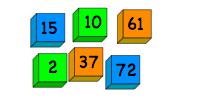Or search by topic
Number and algebra
Geometry and measure
Probability and statistics
Working mathematically
Advanced mathematics
For younger learners
That Number Square




When you arrive in the classroom one morning you discover all the numbers have fallen off the class number square and they are in a heap on the floor. All that is left on the wall is a blank grid!
There are five minutes to go before the first lesson starts.
Your challenge is to find a quick way of putting the numbers back in their right places on the grid.
Where will you start?
You might find it helpful to print out a blank grid and number tiles to cut out.
Once you have had chance to think about how you will put the numbers in place, talk to some of your friends about what they would do.
Or, you could click below to see how some other children got started on this challenge.
Omar and Isla said:
We started with the tens column, counting in tens.
Julia and Chris said:
We started along the top row. We filled in 1 to 10, then you can fill in each column by adding 10 more each time.
Michaela and Nathan said:
We counted in ones because we can do this super-fast!
You could try each of these starting points.
What would you do next? Would this be a quick way for you to put the hundred square back together?
Is there a way of making the hundred square that you think is a particularly 'good' way?
Why? What makes it a 'good' way?
You may also like
Writing Digits
Lee was writing all the counting numbers from 1 to 20. She stopped for a rest after writing seventeen digits. What was the last number she wrote?
Six Is the Sum
What do the digits in the number fifteen add up to? How many other numbers have digits with the same total but no zeros?

